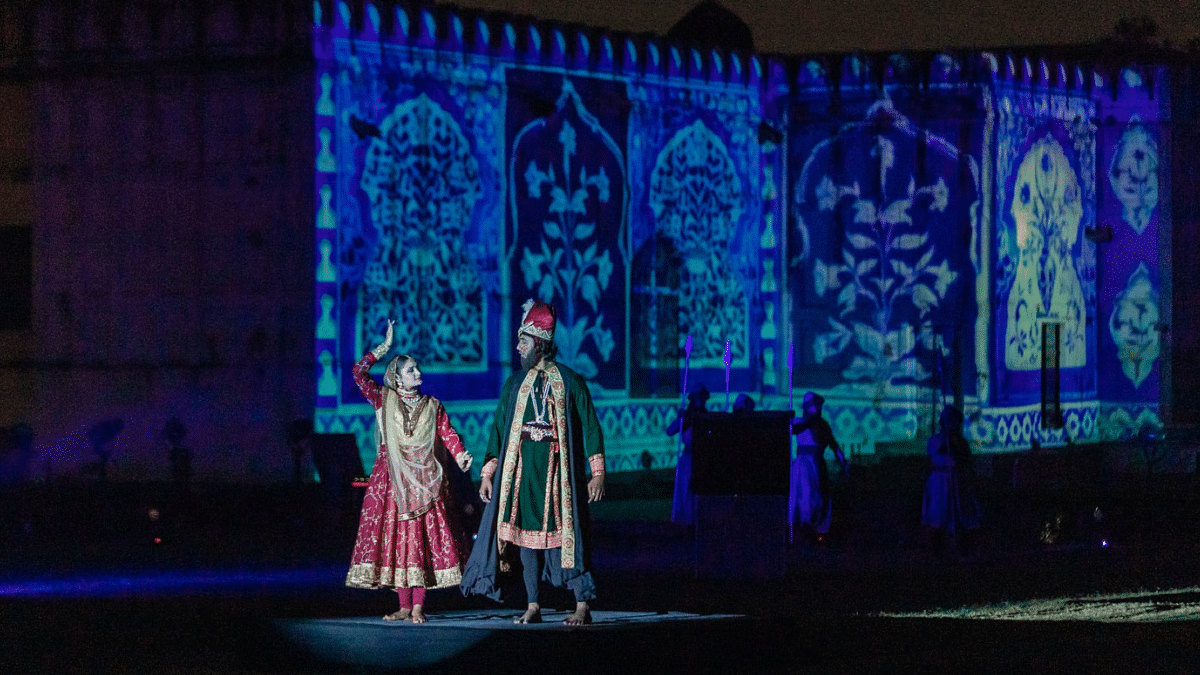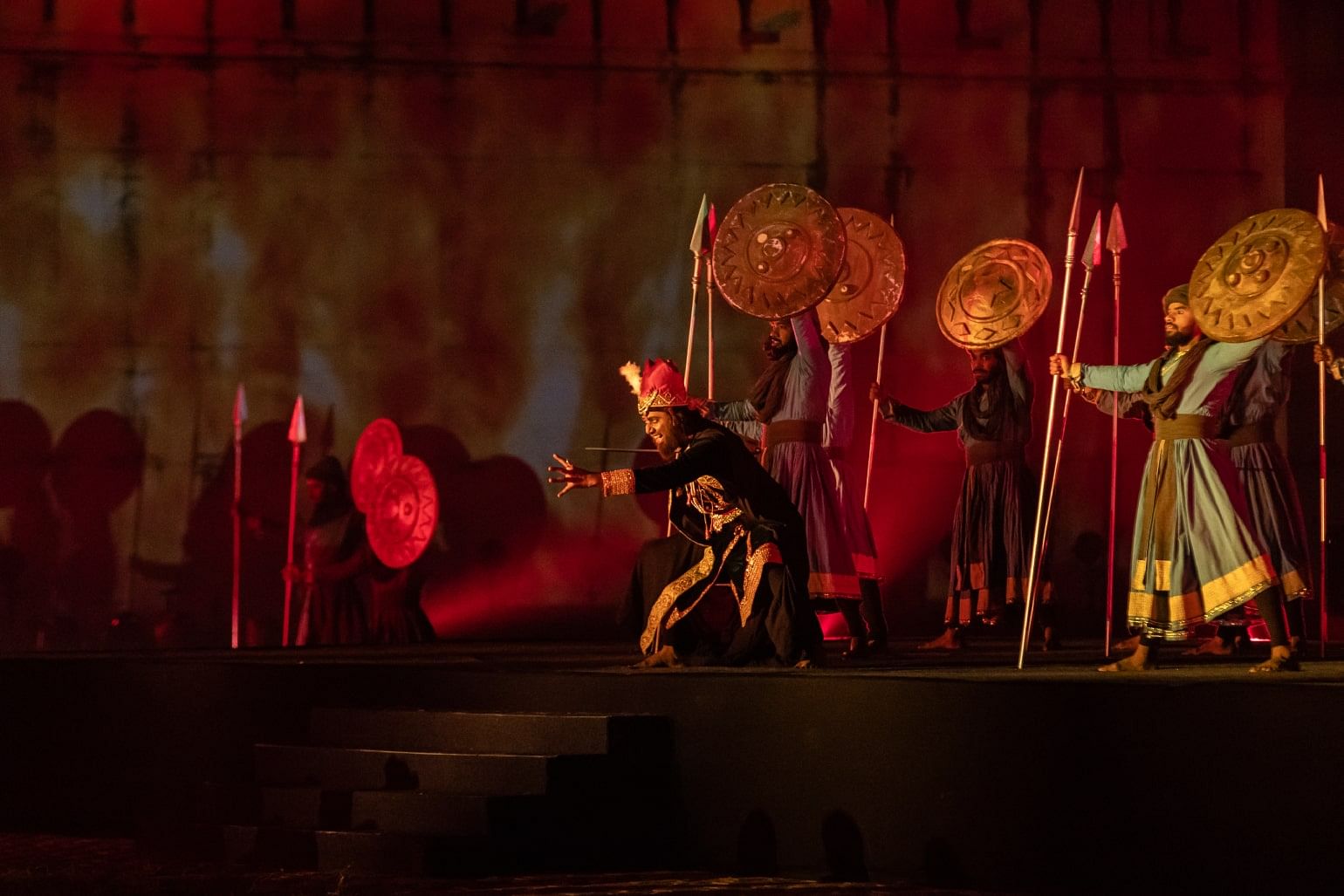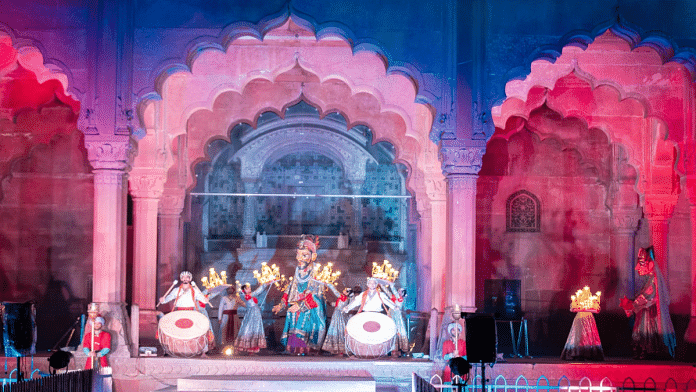New Delhi: We are used to seeing history in books. Today, we will see it unfold: Veteran actor Kabir Bedi’s signature baritone ricochets off the walls of Red Fort’s Diwan-i-Aam. After a gap of nearly five years, ‘Jai Hind’ — Red Fort’s Sound & Light Show — is back. It is history in fast-forward mode. But not India’s history; it is the fort that emerges as the show’s tour de force.
Rolling back time to nearly four centuries ago, a Shah Jahan puppet welcomes the audience to the newly built, brightly lit fort. He speaks to his favourite daughter, Jahanara Begum. The air is heavy with prosperity. Within minutes, everything changes. The emperor is imprisoned, his heir apparent Dara Shikoh is killed. Lights get dimmed, and the fort is given an emphatic makeover.

The mood has completely changed.
“During the reign of Aurangzeb, music, art, poetry, dance, all was strictly forbidden,” thunders Bedi, the English narrator. The show spans three areas of Red Fort: Naubat Khana, Diwan-i-Aam, and Diwan-i-Khas. The third is the site of coalescence — where the history of the fort is woven into the country’s.

After Aurangzeb’s rule, the Mughal dynasty waned, says Bedi. It left a power vacuum that was filled up by other dynasties — the Marathas, Ahoms, and Sikhs.
The Marathas take hold of Delhi with much pomp, and Jai Hind shows that part of history with utmost pride. Mahadji Shinde’s forces capture the fort, and the Diwan-i-Khas is bathed in orange light. About 50 dancers enter the premises, waving saffron flags to a beat that pulsates through the fort.
The backdrop of Jai Hind is as cinematic as it gets, and so are the portrayals of the dramatis personae in Indian history. The East India Company arrives, and a foreboding Bedi says this was the worst invasion in the country’s history. Silhouettes of ships animate the walls, and the viewer knows what’s coming next: The Revolt of 1857, or the First War of Independence.
Also read: Drive out Marxists, focus on Savarkar, Hindu kingdoms — ICHR’s walls now saffron. Literally
Making Lal Qila ‘tourist-friendly’
Jai Hind was conceptualised by the Dalmia Bharat Group as part of ‘Adopt a Heritage: Apni Dharohar, Apni Pehchaan’, a project launched by the Narendra Modi government in 2017.
Dalmia ‘adopted’ the Red Fort, and in 2018, the business conglomerate signed a memorandum of understanding under which Rs 25 crore was allocated for the ‘renewal’ of the fort. Kapil Kumar, professor at IGNOU’s Center for Freedom Struggle and Diaspora Studies, was consulted for the show, but he hasn’t watched it yet.
Jai Hind isn’t their only project. There’s a walk through museum that depicts the construction of the fort, and a projection-mapping show on the “5,000 years of Indian Culture”. These projects are a part of Dalmia Group’s endeavour to make the fort more ‘tourist-friendly.’ Additionally, Matrubhumi showcases the glory of Indian civilisation, focussing on the Vedic Age and dynasties such as the Guptas and Cholas.
“India is the oldest living civilisation. It has gone through cycles of glory and success and struggles and setbacks. It makes us who we are,” says Dalmia Group spokesperson.
Also read: India’s gaanewalis come alive with songs and storytelling – Begum Akhtar to Shobha Gurtu
Did they get history right?
Sohail Hashmi, Delhi-based historian, said he was approached for the curation of Jai Hind but he refused.
“They [the organisers] told me that the history of the Red Fort is the history of Delhi. This is not correct,” he says. The importance of Lal Qila lies in its symbolism — the desire for freedom. It intensified after 1857 when the capital shifted to Calcutta (Kolkata), he adds. “The struggle for freedom was launched at the Red Fort.”
The script was ratified by a panel of five historians appointed by the Archaeological Survey of India (ASI), says the spokesperson of Dalmia Group.
One of the highlights of Jai Hind is the Indian National Army (INA) trials. The trials of Shah Nawaz Khan, Prem Sahgal, and Gurbaksh Singh Dhillon united the nation, Bedi declares. “Lal Qile se aayi awaaz, Sehgal, Dhillon, Shah Nawaz” was the slogan of the day. But there is a missing element, says Hashmi. Jawaharlal Nehru, who fought as legal counsel for the three prisoners, is nowhere in the segment.
“Nehru didn’t utter a single word in the trial. I didn’t indulge in politics, only presented the facts,” says Kumar. “He refused to let the INA prisoners back into the Indian Army,” Kumar claims. Scholars, however, argue that Nehru had not only defended the accused during the trials but had also disagreed with the general consensus against barring INA soldiers from joining the Indian Army after Independence.
The first PM of India arrives, however, to give his Tryst with Destiny speech. It is played for a few seconds, following a declaration by Louis Mountbatten — India is a free nation.
“Certain changes I wanted were not made,” says Kumar, who wanted all of India’s prime ministers to be showcased unfurling the Tricolour. Instead, they are there for mere seconds in the form of postage stamps on a wall.
Then appears Prime Minister Narendra Modi on a bigger screen. “In this Amrit Kaal [most auspicious period], live every day, every second, every part for the motherland,” he says.
(Edited by Humra Laeeq)






